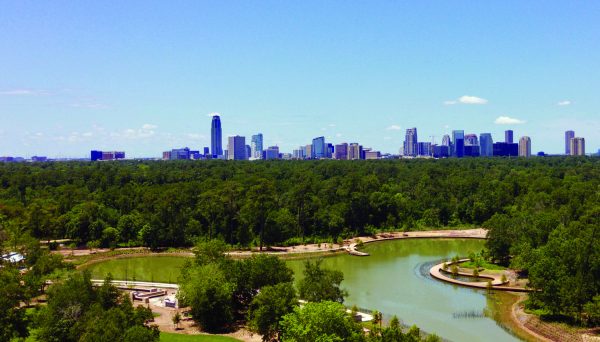100-acre Eastern Glades Opens at Memorial Park

The 100-acre Eastern Glades project includes the 5.5-acre Hines Lake against the backdrop of Memorial Park wetlands and parkland and the Cify of Houston skyline.
Houston: Memorial Park Conservancy and project partners at Houston Parks and Recreation Department, the Kinder Foundation and the Uptown Development Authority are unveiling the Clay Family Eastern Glades, the first major project of the 2015 Memorial Park Master Plan and the associated Ten-Year Plan announced in 2018.
Located north of Memorial Drive between Memorial Park Golf Course and Crestwood Drive, the transformed 100-acre area features picnic areas, native wetlands, savanna, pine-hardwood forest, wide open green spaces, and miles of accessible trails for Houstonians to enjoy.
Eastern Glades is open to the public and can be easily accessed from a parking lot with bike racks along the Seymour Lieberman Exer-Trail and a pedestrian plaza at the intersection of Crestwood Drive and Blossom Street, as well as by vehicle or public transport at the intersection of Memorial Drive and East Memorial Loop Road.
“Eastern Glades provides a much-needed place for people to engage with nature and experience Houston in a whole new way – and our citizens need and deserve this now more than ever. We are grateful for the public-private partnership that allows transformational projects like Eastern Glades. I believe it is important to enhance parks throughout the City to improve the quality of life for every Houstonian,” said Mayor Sylvester Turner.
In addition to reclaiming and restoring 100 acres of largely inaccessible and ecologically distressed parkland for recreation, relaxation, and rejuvenation, the completed Eastern Glades project:
Establishes the 5.5-acre Hines Lake and wetlands providing stormwater detention and reuse for irrigation, and aquatic habitat
Introduces over 2.5 miles of majestic new boardwalks and accessible walking trails as well as opportunities to experience and learn about natural ecology systems
Significantly expands community areas with the opening of Live Oak Court, a new food truck court and event lawn, in addition to three covered picnic pavilions, four picnic areas and a grand lakeside plaza
Draws upon the Park’s history, re-establishing a pedestrian entry at one of the original entrances to Camp Logan, the World War I military training facility for which Memorial Park is named
Features personal quotes from more than 50 Houstonians describing what the Park means to them. Houston’s 2020 Youth Poet Laureate, Madison Petaway, curated these unique quotes for permanent installation around Eastern Glades’ Central Lawn.
“Eastern Glades honors and celebrates what Houstonians love most about the city’s largest urban wilderness and recreation park while providing an expansive new area to explore and discover,” said Shellye Arnold, President and CEO of Memorial Park Conservancy. “We are thrilled to celebrate two important milestones as we deliver this first project of the Master Plan in concert with the 20th anniversary of Memorial Park Conservancy.”
Eastern Glades Phase I opened in October 2018 and included relocating a portion of East Memorial Loop Road; extending the Seymour Lieberman Trail; adding new restrooms, parking, dark-sky pedestrian lighting and multiuse trails for safer biking and walking; and providing drainage infrastructure to facilitate stormwater management and water purification. The Uptown Development Authority funded and led Phase I of the project.
“We are proud to call Houston home, and happy to support Memorial Park as it becomes the preeminent outdoor space for all Houstonians to enjoy now and forever,” said Emily Clay. “Houstonians deserve nothing but the best,” added Robert Clay. Together, the couple contributed $10 million to the Master Plan, naming the Eastern Glades for their family – a fitting gesture that echoes the welcoming feel of this new community gathering space.
An essential component of Eastern Glades includes an extensive ecological restoration and conversion process. The Conservancy’s data-driven and scientifically grounded approach involves removal of invasive species undergrowth, allowing native trees to grow; establishment of healthy forest structure and biodiversity through the addition of native woody species and herbaceous plants; and stewardship through ongoing maintenance.
While the conversion process is ongoing, the resulting restored natural areas will be more resilient to climatic conditions and more hospitable to diverse wildlife.
“The Conservancy has done impressive work restoring nearly 40 acres of degraded habitat in Eastern Glades so far and planting more than 150 native species to help promote and sustain wildlife. Restoring the landscape not only creates wonderful spaces for people to enjoy nature, but also provides important benefits for the overall ecology of the Park and plays an integral role in stormwater management,” said Nancy Kinder, President and CEO of the Kinder Foundation, Ten-Year Plan catalyst donor and project partner. “This opening is just the start of what is to come.”
Nelson Byrd Woltz served as the lead design firm for the Master Plan and the Eastern Glades project. Globally recognized, they were selected based on their successful work with ecologically challenged public spaces.
The total Eastern Glades project cost is $35 million. The City of Houston invested $10 million in Eastern Glades through the Uptown TIRZ for project infrastructure including the moving of a road that had previously cut the 100-acre area in half.
Donors to the Conservancy including Emily and Robert Clay, Wendy and Jeff Hines, the Kinder Foundation and others provided the balance – $25 million – to restore the site’s distressed ecologies and build the amenities.
In 2018, the Kinder Foundation provided a catalyst gift of $70 million to accelerate the delivery of ten years’ worth of Master Plan projects and joined the Conservancy, Houston Parks and Recreation Department and Uptown Development Authority as a project partner for the delivery of these Master Plan projects.
The Conservancy continues raising funds for additional projects as part of its capital campaign.
